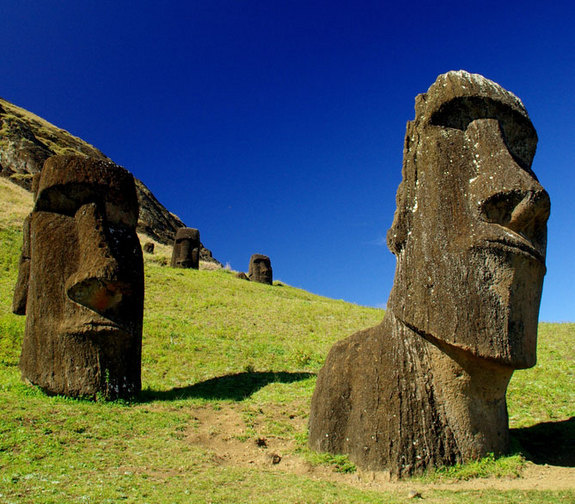Easter Island
POLITICALLY, EASTER ISLAND has belonged to CHILE since 1888, though it lies some 2,200 mi (3,500 km) west of the coast of Chile and just south of the TROPIC OF CAPRICORN in the PACIFIC OCEAN. Its nearest neighbor is PITCAIRN ISLAND 1,132 mi (1,819 km) to the west. The major settlement is Hanga Roa. Easter Island enjoys a subtropical climate tempered by oceanic influences; the annual temperature ranges from 86 degrees F (30 degrees C) in January/February to 57 degrees F (14 degrees C) in July and the annual precipitation is 45.2 in (114 cm).
The island has an area of 64 square mi (166 square km) that is triangular in shape and composed of volcanic rocks. There are three extinct volcanic peaks, the highest is Maunga Terevaka at 2,086 ft (652 m) and between which there are gently rolling lava hills. Two of the volcanic peaks have lakes in their craters that are sources of fresh water. Geologically, the island is young, having been formed by volcanic eruption on the Nazca Plate, a crustal “hot spot,” in the last 2 to 5 million years. The rocks are andesites and basalts, which have produced alkaline to neutral soils rich in clays and loams. The consolidated volcanic ash, or tuff, in the volcanic crater of Rano Raraku provided the material for the monoliths, or statues of large heads known as Moai, which are located along the coast and for which the island is famous.

DEFORESTATION
The current vegetation is grass savanna and is devoid of natural forest/woodland, though there is convincing evidence that several species of trees and woody shrubs were once present, including at least one tree palm. Deforestation had occurred by the time Europeans arrived and its completeness is considered to represent an ecological disaster; certainly soil EROSION is a problem in places.
The island was first seen by the Dutch explorer Jakob Roggeveen, on Easter Sunday, April 6, 1722, an occasion that gave the island its name. There have never been any native mammals but there are indigenous insects, one species of lizard and several land birds, though at least six of the latter have become extinct from human impact. Some afforestation in the interior of the island has been undertaken featuring eucalyptus species, and rodents such as rats and mice have become naturalized.
The origin of the Easter Islanders has been controversial. The anthropologist Thor Heyerdahl, proposed that they originated in PERU and built a balsa raft. He imitated their journey with native boats and sailed from Peru to the island to prove that the trip was possible. However, it is now accepted that they originated in Polynesia, possibly from the Marquesas Islands, and arrived on Easter Island about 600 years ago. The Moais, huge native statues, of which there are more than 1,000, were erected between 1000 and 1650 C.E. They are a major tourist attraction and there are rock paintings (petroglyphs) which also depict human life. The Rapa Nui National Park, covering most of the island, was established in 1935 to protect the archaeological remains. The islanders used Rongorongo script, the sole written language of Oceania.
Today, the population is about 3,000, having recovered from a major decline following initial contact with Europeans which brought disease and slavery. Tourism is a major source of work and income. There is a rich artistic tradition involving carvings, tattooing, and music.
